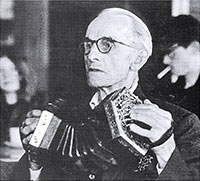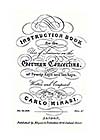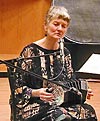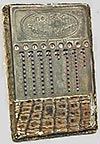The usual explanation of the destinations of concertinas when they first
left the manufacturers is that the English system being more expensive went
into middle class drawing rooms while the cheaper Anglos went into the
working class kitchens and thence into the tradition. If this statement is
to be of any great value against the broader picture it needs to acknowledge
that to be able to afford any instrument indicates a certain level of
disposable income and, of course, there were other even cheaper alternatives
like the mouthorgan and melodeon, but nevertheless it is a reasonable
starting point.
So the world was awash with concertina players and Mayhew appears to
confirm this. An interview in 1861 referring to the previous decade states
that the ‘instrument was very fashionable then and everybody had it nearly.’
There must have been very many Anglo players. Thus we have Fred Kilroy,
William Kimber, Scan Tester, and … er … and … ?? Kilroy names some
other players, Kimber’s brother played as did Tester’s, and there were the
Liverpool bandsmen; someone will, doubtless find references in old sleeve
notes or interview transcripts (‘Mother always sang on a Saturday morning
while she churtled the grinings and grandfather had a concertina so there
was always a lot of music in the house …’; you know the sort of thing!),
but thousands upon thousands of Anglos were made. The International
Concertina Association speaks of two hundred thousand Anglos and while some
went abroad to places such as Ireland and South Africa I think we can feel
that the random survival system which controls our knowledge of the
tradition has been particularly harsh on the Anglo Concertina.
I have always been rather moved by the famous quotation from Sir Thomas
Browne: What song the Sirens sang, or what name Achilles took when he hid
himself among women, though puzzling questions, are not beyond all
conjecture.
It shows a glorious and naive faith in the power of scholarship to find an
answer against all odds. It also, I suspect, recalls an age when amateur
‘scholars’ had a lot of time on their hands and were not troubled by today’s
rigourous standards of methodology. I fear it is also close to rubbish in
our case. I’m afraid the truth has to be that there is not enough evidence
to state very much with any certainty about early Anglo playing and this is
very unlikely to change; we should not hold our breath waiting for an old
forgotten box in a neglected attic to reveal its store of cylinder
recordings made by an early Anglo-phile whilst on cycling holidays in
Southern England between the wars.
There is, therefore, insufficient evidence to address the question, ‘Is
there a traditional English style of Anglo playing?’ The situation might
have been different if Kilroy, Kimber and Tester had more in common, but
they don’t. Kilroy, flowed across the rows in a range of keys, with melody,
counter melody and broken chords above and below the tune (though, from the
little to which I have access, played traditional tunes up the rows with
more usual use of the bellows). Kimber played in the crisp, clipped style
which is instantly recognisable and apparently in imitation of his father,
punching full chords on the left hand and sometimes adding on the right.
(Dan Worrall,
in Texas, has painstakingly endeavoured to work out Kimber’s
fingering and come up with the idea that his father learnt on a twenty key
instrument as Kimber himself virtually never used the top row!) Tester is
different again with a distinctive way of playing in octaves with the
occasional bass note.
What these three do have in common is the way that their playing
reflects their background and context. Kilroy, a reader and bandsman, used
to playing parts; Kimber, a dance musician inseparably linked to the
Headington Quarry tradition; Tester, a community musician with the
repertoire for the dance, the public house and the streets. I also wonder
whether Tester’s approach was affected by the realities of playing for
dances in the days before amplification; the need to be loud. With piano and
drums relieving the left hand from the necessity of providing accompaniment
and driving in the rhythm playing octaves makes sure the tune carries
strongly. I have a recording made by Bob Davenport of Scan Tester in a
session with The Marsden Rattlers and others (not quiet company!) and there
is no doubt that the concertina is leading from way out in front.
The second half of the twentieth century saw the activity that has
become known as the Folk Revival. Whatever its musical validity the
historical fact is that it reached the ears of many who may never otherwise
have heard the music it presented. Some of those went beyond the revival and
discovered and came to love the traditional music that they found somewhere
in the background. Some of those, with knowledge, understanding and talent,
are now performing within the traditional style and function so superbly
that the difference between ‘folk’ and ‘traditional’ becomes harder to
define. The Anglo emerged loudly in this new context which fortunately
coincided with the presence of quality instruments at low prices in
secondhand junk shops.
Very few of this generation of players set out to imitate earlier
players. It was not a particularly practical option. Fred Kilroy is still
not commercially available, the EFDSS Kimber LP was hard to find though the
later Topic issue of the Morris tunes and recordings on cassette from Peter
Kennedy were widely available and I do remember hearing some effective
imitators playing for Morris in the late 70s. I don’t know how well the 78s
had sold. Scan Tester, before Reg Hall’s landmark double LP in 1990, was
very under-represented on compilations and the subject of one cassette from
Peter Kennedy which contains a lot of Bandoneon and gives me the overall
impression that Scan was not at ease at that session.
It was necessary for us to find our own approach. Some, unconsciously
following Fred Kilroy, worked to play across the rows in a variety of keys.
This is not easy and these players are very competent musicians. They also
tend to be the players with 39/40+ buttons on their instruments and who are
also interested in playing music beyond the ‘folk’ repertoire. John
Kirkpatrick can stand as an example of this, but mention must be made of
the late Andrew Blakeney-Edwards. Andrew exploited all the bounce and drive
of good bellows control with a full, adventurous, and varied left hand. His
performance of Scott Joplin rags was the greatest piece of virtuoso Anglo
playing that I have ever experienced.
Most players found a simpler approach, playing in the home keys with
chords along the rows on the left hand and following the straightforward in
and out of the bellows. This is closer to Kimber and probably reflects what
Kimber senior did: picked up an unfamiliar instrument and said ‘I know what
I want to play on this. Now, what’s the best way to do it?’ The approach is
fully satisfactory for dance tunes and this was the role of the Anglo is
most cases. If it caused the neglect or abandonment of the inappropriate
chords that often seeped out of piano accordians (and were enshrined in too
many EFDSS tune collections!) then I see no problem with that!
It was also the approach most commonly used by those who used the Anglo
to accompany singing. This is much harder than it sounds and many have given
up in the face of the huge problems coordinating bellows and lungs. Many
Anglo players cannot speak a word while playing!
In essence the two main rows of an anglo give the major scale as you go
in and out along the buttons. Holding down a combination of buttons in a row
gives the basic chords. The bellows direction chosen for the right hand,
where most players place the tune, happily creates the matching chord on the
left hand and the famous three chord trick is easily achieved. (Purists may
stick to two!) This technique allows the tune to come uncluttered from the
higher notes of the right hand while the left hand fills out accompaniment
and the bellows lead the way to providing a crisp rhythm. This is totally
adequate for solo or group playing. It is also a solid base from which
playing technique can be extended, and for those who are reading this in the
hope of moving into an extended way of playing, I suggest that the places to
go first are bass patterns with the left little finger and then, using the
same left/right approach attempt the next two ‘outside’ keys, i.e. F and D
if you have a C/G instrument. This will also help you to play in C on the G
row and in G on the C row which is very useful, especially for playing lower
notes in G without going onto the left hand and higher notes in C without
changing hand position. Clear as mud? Think it through!
So far this has all been about technique and this must not be confused
with style. Technique is the mechanics, style is the music. I began with the
cold fact that we cannot posit an English style of Anglo playing, but it is
quite possible to learn a style of music from a player of another instrument
and transfer this to the Anglo. After all, when Kimber played for Headington
quarry he was following two fiddle players who were following a pipe and
tabor. Obviously the in/out characteristic of the melodeon and the
mouthorgan are particularly appropriate and a musical giant like Oscar Woods
(the melodeon player not the bluesman!) influenced all who heard him
regardless of instrument. His pace, drive, and understated decoration in the
form of repeated notes was imitated by fiddles as well as free reeds.
As with many things in life, from cars to computers to cricket bats,
there comes a point where you are restricted by the limitations of your
equipment. Some great musicians get around this by fine tuning the elements
that are available to them and the result is often magnificent music; again
Oscar Woods is a perfect example. Most, however, will find that their
leaking old Lachenal lacks the wind or the speed of response that they seek.
Unfortunately one of the major changes of the past thirty years has been the
disappearance of quality instruments at reasonable prices. Quality new
instruments command professional prices. I bought my first new instrument, a
Neville Crabb masterpiece, for £198 in the mid 70s and this represented over
10% of my annual income, but at this time good, older concertinas with a
lifetime’s playing still in them in return for sensible treatment, were
available at half that price. Those really were good old days and they have
passed. I am constantly surprised when I see the prices commanded by
secondhand instruments which were never top quality when they were made and
probably don’t have much life left. The specialist websites (e.g. the
excellent www. concertina.net)
contain ongoing discussions about the merits
of cheaper new instruments from Europe. These are not easy days for the new
enthusiast.
One thing that remains unchanged is the Anglo’s place in the music. Its
close relations have a separate existence in the classical world, in South
American concerti, on Parisian pavements. The Anglo’s fruit stays close to
the tree.
The original version of this article
appeared in
English Dance and Song
(magazine of EFDSS,
the English Folk Dance and Song Society),
vol. 64, no. 2 (Summer 2002), 6–7.
Author
Roger Digby
(
)
has an academic background in the Classics and Education and he
has spent his entire adult life teaching in the tough Comprehensive schools
of Inner-London Islington. This random move in the early 70s found him
living 100 yards from Crabb’s Liverpool Rd. workshop, close to some pubs
where the Irish music was the best in London and joining the company of
friends who in 1975 became ‘Flowers and Frolics’, a band at the sharp end of
what has become known as the English Country Music revival. They released
two influential vinyl LPs before calling it a day in 1985. A reunion in 1999
created a CD
‘Reformed Characters’ (available at www.danquinn.co.uk).
With ‘Flowers’ as resident band, Roger joined with singer Bob Davenport to
run the music nights at the Empress of Russia, a legendary music club which
was famously described by Melody Maker as the ‘most adventurous acoustic
venue in the country’. Bob and Roger still work as a duo and have released two
CDs (www.topicdrift.com/davenport).
Roger's most recent recordings are
included in the three CD compilation ‘Anglo International’
(available at www.angloconcertina.co.uk).
Roger has now moved ‘back home’ to his native North-East Essex where he
reads, gardens, walks his dogs, brews beer and enjoys retirement. He is
the Review Editor of
Papers of the International Concertina Association (PICA).






